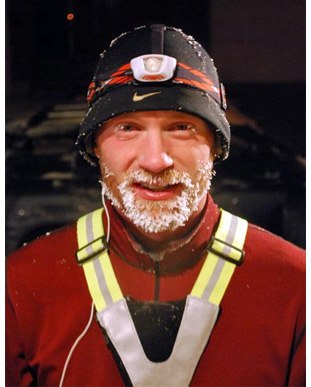Does the thought of running in the cold send shivers down your spine? Here are some tips that work wonders for the best time of the year for running.
Winter weather is the best for running…if you’re prepared.
 Is the fear of winter weather legitimate? There is no question that if runners are improperly clothed they are putting themselves at risk. In order for the vital core organs to stay warm and functioning in the cold weather, blood flow to the extremities slows down, causing the hands, arms, legs and feet to feel numb and cold. The body stops using fat as a source of energy, which causes runners to fatigue much more quickly. As runners fatigue they are unable to maintain a pace that will generate sufficient heat to keep them warm and they become chilled. It often takes runners the rest of the day to warm up after this happens. This is the story that has discouraged many from the joys of winter running.
Is the fear of winter weather legitimate? There is no question that if runners are improperly clothed they are putting themselves at risk. In order for the vital core organs to stay warm and functioning in the cold weather, blood flow to the extremities slows down, causing the hands, arms, legs and feet to feel numb and cold. The body stops using fat as a source of energy, which causes runners to fatigue much more quickly. As runners fatigue they are unable to maintain a pace that will generate sufficient heat to keep them warm and they become chilled. It often takes runners the rest of the day to warm up after this happens. This is the story that has discouraged many from the joys of winter running.
The fact of the matter is, winter is the best time of the year to run, in spite of the cold weather. It is in fact the cold that makes it the best time of the year to run. The cold weather allows a runner to dress to his or her own heat requirements and stay comfortable through any condition, as long as they have the right gear and clothing. It is impossible for runners to run at their optimum temperature in the summer. You can only cool down so much when the temperature is in the 90s.
So, what is the key to staying warm in the winter?
Rule 1: No cotton!
Skiers have known it for years, nothing containing cotton is good for cold weather. Cotton absorbs sweat and traps it next to the skin. When the skin is wet the body loses heat up to 25 times faster than it does when it is dry. Cotton clothing is the main culprit for the bad reputation of winter running. A good rule of thumb: The first layer of cotton is the last layer of warmth.
Rule 2: Layer with the proper gear for the conditions. An easy acronym to remember is Support V.I.P.
This doesn’t mean a runner needs to wear four separate pieces of clothing to satisfy this layering system. There is clothing that combine slayers so the runner is much more comfortable compared to leaving the house feeling like a marshmallow. Some pieces combine all the layers into one, and some only combine two or three of the layers. Runners can pick and choose what works best for them based on their own ability to generate heat and what the temperature, wind and precipitation conditions are for that day.
Rule 3: A runner should not be warm when starting a run.
Remember, you’re not going to a football game or sitting in a duck blind. The body will generate its own heat during exercise. If a runner is warm at the beginning of the run, he is overdressed and will overheat. When the body overheats the amount of sweat perspired will overwhelm even the best technological clothes and will put the body at risk for the dreaded chilling effect. It is normal to be chilly for the first few minutes of the run. If the runner is patient, before long, he or she will be comfortable and have an enjoyable experience running in the best season of the year.
